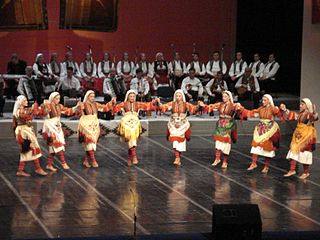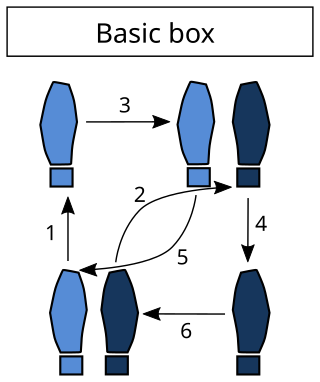
The music of Bulgaria refers to all forms of music associated with the country of Bulgaria, including classical, folk, popular music, and other forms.

Hora, also known as horo and oro, is a type of circle dance originating in Aromanian and Romanian communities, especially in Romania and Moldova. It is also found in other South East European countries and culturally adopted by ethnic minorities such as the Ashkenazi Jews and the Roma.

Box step is a basic dance step named after the pattern it creates on the floor, which is that of a square or box. It is used in a number of American Style ballroom dances: rumba, waltz, bronze-level foxtrot. While it can be performed individually, it is usually done with a partner. This is the most common dance step in the waltz. In international standard dance competition, there is a similar step called closed change.
The music of Thrace, a region in Southeastern Europe spread over southern Bulgaria, northeastern Greece, and European Turkey, contains a written history that extends back to the antiquity, when Orpheus became a legendary musician and lived close to Olympus. Though the Thracian people were eventually assimilated by surrounding Balkan groups, elements of Thracian folk music continue.
Leventikos ; or Bufčansko, also known as Litós (Λιτός), Kucano, Nešo or Pusteno, is a dance of western Macedonia, mainly performed by ethnic Macedonians and Greeks in the town of Florina, Greece and in the Resen and Bitola regions in the neighbouring North Macedonia.
Pajdushko oro; is a folk dance from Macedonia. It features a 5-beat meter divided into "quick" (2-beat) and "slow" (3-beat) units, abbreviated quick-slow or 2+3.time. Like many other Balkan folk dances, each region or village has its own version of the dance. It is traditionally a men's dance, but in modern times it is often performed in lines of both men and women.
Zonaradiko is a traditional Greek folk dance from Thrace (Greece) that is named after the dance's handhold. Dancers hold the adjacent dancer's zonaria (belt) during the dance. Zonaradiko is a village line dance done in one form or another all over Greece. In each village the dance will look somewhat different, but the basic structure is essentially the same. The same dance is done in Bulgaria under the name Pravo. The variations below are a collection of steps commonly done by folk dancers throughout the US and as seen done by various groups in Greece.
The country/western two-step, often called the Texas two-step or simply the two-step, is a country/western dance usually danced to country music in common time. "Traditional [Texas] two-step developed, my theory goes, because it is suited to fiddle and guitar music played two-four time with a firm beat [found in country music]. One-two, one-two, slide-shuffle. The two-step is related to the polka, the Texas waltz, and the jitterbug.
The Texas two-step is the same step known to ballroom dancers as the international fox-trot. Except for the one-step, which is just that, most Texas dances are variations of a two-step, also called a half-step, which is simply a step-close-step. The Texas two-step is generally done with two long steps and a step-close-step to two-four time. Speeded up, it's a shuffle or double shuffle, but still a two-step.
Kopanitsa or kopanica is the name for a family of lively folk dances from western Bulgaria done to music in 11
8 meter, and also sometimes for the accompanying music. Some sources describe the rhythm in terms of "quick" and "slow" beats, the pattern being quick-quick-slow-quick-quick. The name comes from the verb kopam, which means "to dig" or "to hoe", so the name is sometimes translated as "little digging dance". As with other Balkan dances, different regions and even different villages have their own variations of the dance.
Gankino horo is a Bulgarian folk dance written in 11 (undecuple) = 2+2+3+2+2 time similar to kopanitsa or krivo horo. The name gankino seems to be used mostly in northern Bulgaria. The basic gankino horo is a three-measure dance using the step structure also common in the dances: Dunavsko, Povarnoto and Eleno Mome.

Assyrian folk dances are sets of dances that are performed throughout the world by Assyrians, mostly on occasions such as weddings, community parties and other jubilant events.
Zydeco as a dance style has its roots in a form of folk dance that corresponds to the heavily syncopated zydeco music, originated in the beginning of the 20th century among the Francophone Creole peoples of Acadiana. It is a partner dance that has been primarily danced socially and sometimes in performances.
Yove male mome, also called Povela e Yova, is a fast Bulgarian folk dance. It is done to a 7+11
16 = 18
16 compound meter with alternating (sub-)bars of 7+11, in their turn divided into common chetvorno and kopanitsa rhythms. Some dancers count it as 3-2-2, 2-2-3-2-2 or SQQ-QQSQQ, "S" meaning "slow", and "Q" meaning "quick". It originates from the traditional dance Jove from the Shopluk region of Bulgaria.
Dajchovo horo is a Bulgarian folk dance done to a nine-beat meter. It is unique in two ways: it is a circle dance, and yet it has a leader.
Syrtos is – in classical and modern Greece – a traditional dance in which the dancers link hands to form a chain or circle, headed by a leader who intermittently breaks away to perform improvised steps.
Pravo horo is a very popular, simple folk dance from Bulgaria that is done throughout the Balkan countries. In Greece, it is called Zonaradiko. It is considered the "national dance" of Bulgaria, Albania, and North Macedonia. It is a rustic village line dance with a three-measure pattern, done to 2
4 or 6
8 music, and is a staple of weddings, feast days, and other celebrations. As with other Balkan dances, each country and even local region has its own variation of the dance, often interspersing other steps with the basic pravo step, to the extent that these different versions amount to distinct dances.
Lesnoto, or Lesno, is the name of a family of simple, popular folk dances from North Macedonia, also done in Bulgaria and parts of neighboring Balkan countries. It is a line dance, usually done to a seven-beat meter organized in a slow, quick, quick rhythm, often abbreviated 3+2+2. The common factor of all the forms is a pattern of "three steps to the right, one step to the left". These are probably the most common dances in the region, done at parties and mehanas (cafés) to both traditional and modern music.

EastWind is an album by Andy Irvine and Davy Spillane, showcasing a fusion of Irish folk music with traditional Bulgarian and Macedonian music. Produced by Irvine and Bill Whelan, who also contributed keyboards and piano, it was widely regarded as revolutionary at recording.
The Collegiate Shag is a partner dance done primarily to uptempo swing and pre-swing jazz music. It belongs to the swing family of American vernacular dances that arose in the 1920s and 30s. It is believed that the dance originated within the African American community of the Carolinas in the 1920s, later spreading across the United States during the 1930s. The shag is still danced today by swing dance enthusiasts worldwide.
Petrunino horo is a Bulgarian dance from the Shopluk region in middle-west Bulgaria.









